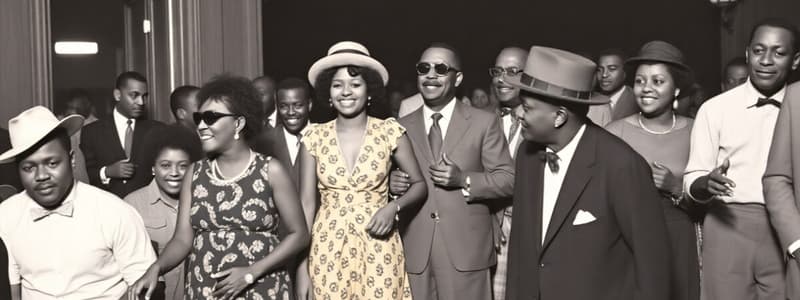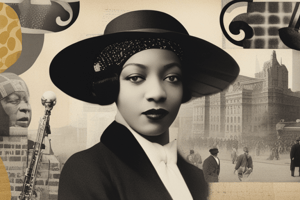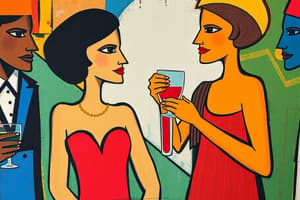Podcast
Questions and Answers
What was a major cause of the Great Depression?
What was a major cause of the Great Depression?
- The rapid expansion of international trade agreements
- Over-speculation in the stock market and unsustainable business practices (correct)
- Increased government regulation of the stock market
- Decreased agricultural production due to technological advancements
Which name refers to the cultural movement that celebrated African American art, music, and literature in the 1920s?
Which name refers to the cultural movement that celebrated African American art, music, and literature in the 1920s?
- The Jazz Age
- The Harlem Renaissance (correct)
- The Red Scare
- The Great Migration
What was the purpose of President Franklin D. Roosevelt's 'Fireside Chats'?
What was the purpose of President Franklin D. Roosevelt's 'Fireside Chats'?
- To criticize the Supreme Court's opposition to his New Deal programs.
- To rally support for increased military spending
- To promote isolationist policies during the looming threat of WWII
- To directly communicate with the American public and restore confidence during the Depression (correct)
Which of these terms refers to the fear of radical and socialist ideas that gripped the United States after World War I?
Which of these terms refers to the fear of radical and socialist ideas that gripped the United States after World War I?
What was the main goal of President Franklin D. Roosevelt's New Deal programs?
What was the main goal of President Franklin D. Roosevelt's New Deal programs?
Flashcards
Roaring Twenties
Roaring Twenties
A period in the 1920s marked by economic prosperity, cultural change, and social freedoms in the U.S.
Harlem Renaissance
Harlem Renaissance
An African American cultural movement in the 1920s centered in Harlem, New York, highlighting art, literature, and music.
Prohibition
Prohibition
A nationwide ban on the production, importation, transportation, and sale of alcoholic beverages from 1920 to 1933 in the U.S.
Great Depression
Great Depression
Signup and view all the flashcards
Dust Bowl
Dust Bowl
Signup and view all the flashcards
Study Notes
The Roaring Twenties
- Characterized by economic prosperity, social change, and cultural innovation.
- Marked by a period of rapid technological advancements and mass production.
- Increased consumerism and the rise of new leisure activities.
- Significant social changes in attitudes toward women's roles, fashion, and entertainment.
The Great Migration
- Movement of African Americans from the Southern United States to Northern cities.
- Driven by racial discrimination, violence, and lack of economic opportunity in the South.
- Led to the growth of Black communities and a burgeoning Black middle class in the North.
Harlem Renaissance
- Period of flourishing creativity in African American literature, art, and music.
- Centered in Harlem, New York.
- Celebrated African American culture and identity.
- Major figures include Langston Hughes, Zora Neale Hurston, and Duke Ellington.
Prohibition
- Period from 1920 to 1933 when the manufacture, sale, and transportation of alcoholic beverages were illegal in the United States.
- Led to the rise of organized crime and speakeasies.
- Failed to achieve its intended goals of reducing alcohol consumption and related social problems.
Jazz Age
- Period in the 1920s characterized by the popularity of jazz music.
- Became a defining cultural movement, influencing fashion, dance, and entertainment.
- Jazz musicians such as Louis Armstrong and Duke Ellington gained immense popularity.
The Red Scare
- Period of intense fear of communism and radical ideologies.
- Incited by fears of Soviet influence and revolution in the United States.
- Led to the arrest and deportation of suspected radicals.
- Resulted in a climate of political repression and civil liberties violations.
Stock Market
- Experienced rapid growth and speculation during the 1920s.
- Led to an unsustainable market bubble.
- Major factors driving the speculative boom included easy credit, investment in new industries and limited regulation.
Great Depression
- Severe worldwide economic downturn that began in 1929.
- Triggered by the Wall Street Crash.
- Associated with high unemployment rates, bank failures, and poverty.
- Led to social and political upheaval across the globe.
Unemployment
- Skyrocketed during the Great Depression.
- Significant loss of jobs across various industries.
- Led to widespread poverty and hardship.
- High unemployment rates had devastating effects on families and communities.
Hooverville
- Shantytowns that sprang up during the Great Depression.
- Built by the homeless and unemployed.
- Named after President Herbert Hoover, who was criticized for his handling of the economic crisis.
- Demonstrated widespread poverty and hardship.
Dust Bowl
- Severe drought and dust storms that devastated the agricultural regions of the American Midwest.
- Led to massive crop failures and displacement of farmers.
- Affected the Great Plains region.
- Contributing factor to the widespread poverty of the Great Depression.
Fireside Chats
- Radio addresses delivered by President Franklin D. Roosevelt.
- Used to communicate with the American public during the Great Depression.
- Provided a sense of reassurance and hope during a tumultuous time.
- Helped to build public trust in the government
New Deal
- Series of programs implemented by the Roosevelt administration.
- Aimed at providing relief, recovery, and reform during the Great Depression.
- Included programs for job creation, financial reform, and agricultural assistance.
- Provided crucial support and a framework for social welfare programs.
Studying That Suits You
Use AI to generate personalized quizzes and flashcards to suit your learning preferences.




